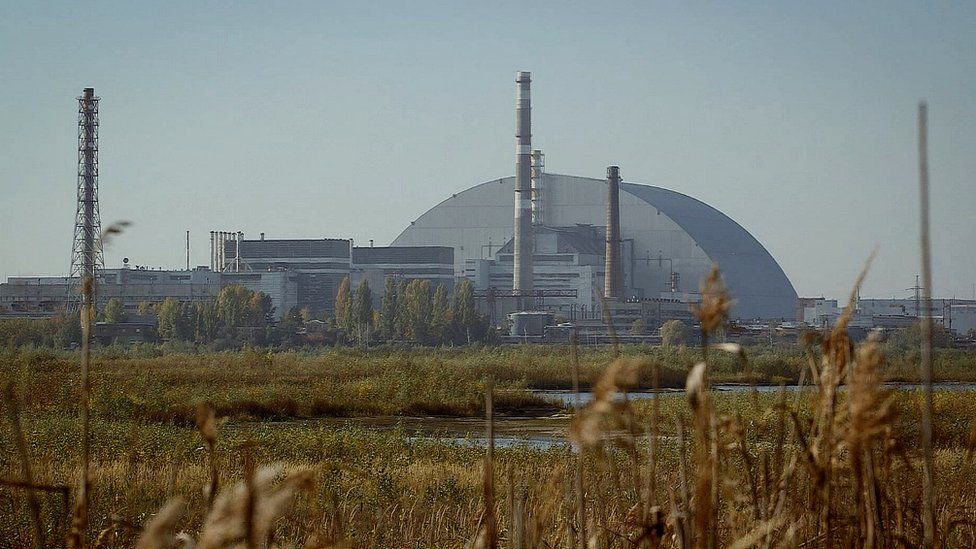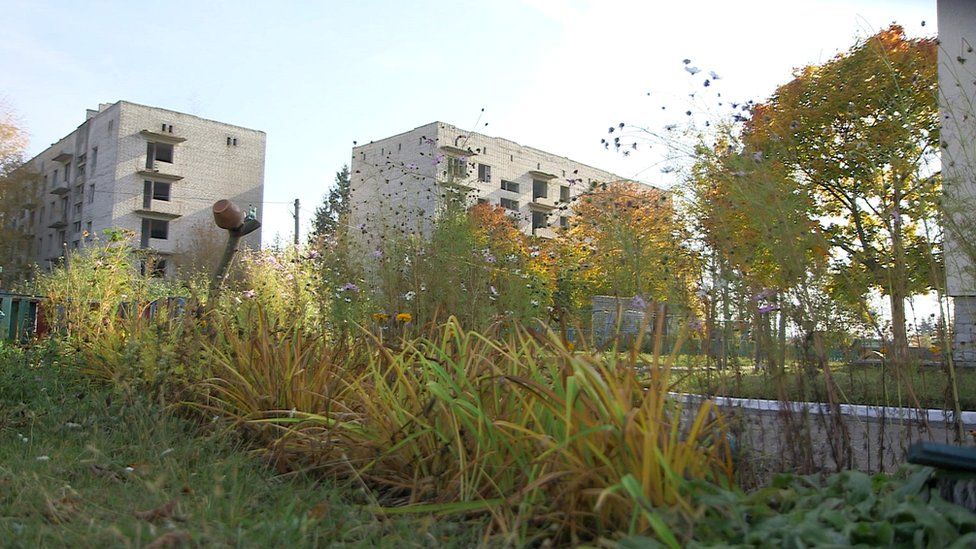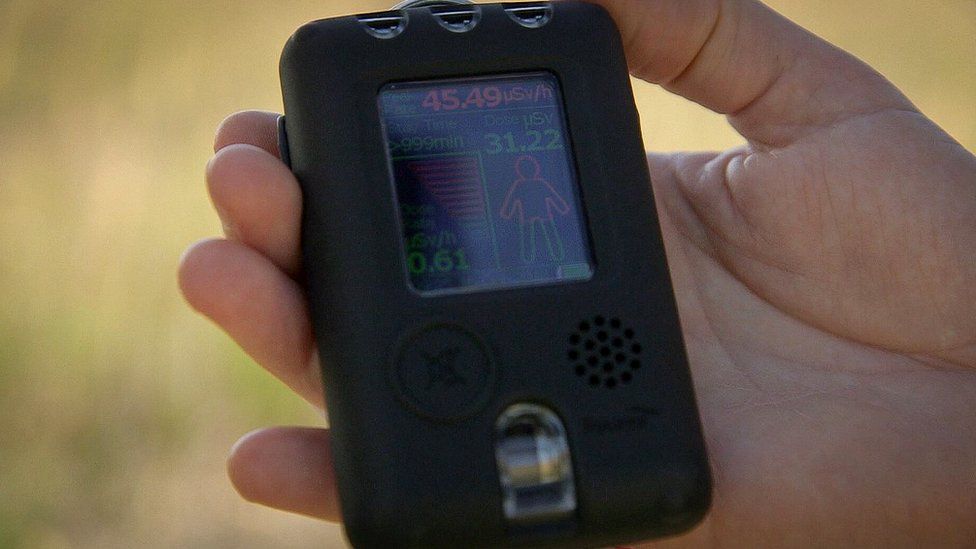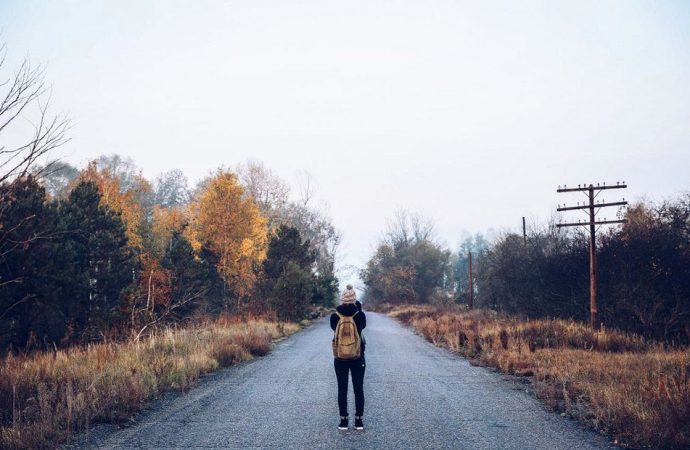Since the explosion at the Chernobyl nuclear power plant in 1986, an area of more than 4,000 square kilometres has been abandoned. That could be about to change, as Victoria Gill discovered during a week-long trip to the exclusion zone.
“This place is more than half of my life,” says Gennady Laptev. The broad-shouldered Ukrainian scientist is smiling wistfully as we stand on the now dry ground of what was Chernobyl nuclear power plant’s cooling pond.
“I was only 25 when I started my work here as a liquidator. Now, I’m almost 60.”
There were thousands of liquidators – workers who came here as part of the mammoth, dangerous clean-up operation following the 1986 explosion. The worst nuclear accident in history.
Gennady shows me a coffee table-sized platform, installed here to collect dust. This reservoir’s bed dried out when the pumps taking water from the nearby river were finally switched off in 2014; 14 years after the remaining three reactors there were shut down.
Analysing dust for radioactive contamination is just a small part of the decades-long study of this vast, abandoned area. The accident turned this landscape into a giant, contaminated laboratory, where hundreds of scientists have worked to find out how an environment recovers from nuclear catastrophe.
The experiment that turned into a global catastrophe

On 26 April, 1986, at 1:23AM, engineers cut power to some systems at Chernobyl nuclear power plant’s number 4 reactor. It was a critical point in a test to understand what would happen during a blackout. What engineers did not know was that the reactor was already unstable.
The cut-off slowed turbines that drove cooling water to the reactor. As less water turned to more steam, the pressure inside built. By the time operators realised what was happening and tried to shut down the reactor, it was too late.
A steam explosion blew the lid off the reactor, exposing the core to the atmosphere. Two people in the plant were killed and, as air fuelled a fire that burned for 10 days, a cloud of radioactive smoke and dust was carried on the wind around Europe.

The first emergency workers rushed in as lethal smoke billowed out. Of 134 who were diagnosed with acute radiation sickness, 28 died within months. At least 19 have died since.
Gennady, an environmental scientist with the Ukrainian HydroMeteorological Institute, started work in the zone just three months after the evacuation. “We used to fly in by helicopter every day from Kiev,” he explains, “to collect water and soil samples.
“The important thing then was to understand the extent of the contamination – to draw the first maps of the exclusion zone.”
Today, that zone spans Ukraine and Belarus. Covering more than 4,000 sq km – more than twice the size of London. Every community within a 30km radius of the plant was evacuated and abandoned; no-one was allowed to return here to live.
In a forgotten, outer portion of the exclusion zone, people were quietly allowed to return home a few months after the disaster.
Unlike the “30km zone”, no checkpoints prevent entry to this semi-abandoned area. Narodichi, a town of more than 2,500 people, is within that more-distant zone. Strict rules govern this officially contaminated district; exclusion zone land must not be cultivated to produce food and it cannot be developed.

Today, though, this part of Ukraine is not easily delineated into two categories – contaminated or clean. Research has shown that Chernobyl’s aftermath is more complicated, and the landscape here much stranger – and more interesting – than the stringent “do not touch” rules in Narodichi would imply.
Fear of radiation could actually be hurting the people of Narodichi far more than the radiation itself.
‘We’re getting less radiation here than on the plane’
Over Gennady’s shoulder, I can see the nuclear power plant – less than a kilometre away from the reservoir bed we’re standing on. Gleaming in the sunshine is the huge protective steel “New Safe Confinement” that now entombs unit 4. It was slid over the top of the accident’s epicentre in 2016. Beneath it, robotic cranes are dismantling 33-year-old, radioactive wreckage.
Prof Jim Smith from the UK’s University of Portsmouth, a colleague of Gennady’s, is a scientist who has studied the aftermath of the disaster since 1990. Here on one of his numerous research trips to the zone, he shows me a dosimeter – a black plastic phone-sized gadget he carries throughout the visit.
It measures the external dose of radiation he is getting from the environment. Atoms of the nuclear fuel dust that were scattered here by the 1986 explosion are spontaneously breaking down. They are giving out high-energy rays as they do so, and Jim’s dosimeter is detecting the dose of those that we are receiving every hour.

The readings are in units (called microsieverts) that only make sense to me in the context of other relatively “radioactive activities”. At one point in the middle of the flight to Kiev – for example – his dosimeter read 1.8 microsieverts per hour.
“It’s currently 0.6,” Jim says. “So that’s about [a third] of what we were getting on the flight.” With the infamous power plant visible in the background, I’m incredulous. But, Jim explains, we live on a radioactive planet – natural radioactivity is all around us. “It comes from the Sun’s rays, from the food we eat, from the Earth,” he says. That is why, up at 12,000m on an airliner, with less shielding from Earth’s atmosphere, we receive a higher dose.
“Yes, the exclusion zone is contaminated,” he tells me, “but if we would put it on a map of radiation dose worldwide – only the small ‘hotspots’ would stand out.
“Natural radioactivity is all around us – it varies from country to country, from place to place. Most of the area of the exclusion zone gives rise to lower radiation dose rates than many areas of natural radioactivity worldwide.”
‘You don’t want to be in the hotspots for long’
While the boundary of the exclusion zone has not changed, the landscape has – almost beyond recognition. Where people were forced out, nature has moved in. Wilderness combined with abandoned buildings, farms and villages gives a sense of the post-apocalyptic.
Jim and his colleagues spend their days here collecting samples and planting cameras and audio recorders, which silently gather information about what wildlife inhabits this post-human place, and how the radiation affects it.
On the second day of our trip to the zone, I follow the team into the Red Forest. This is an exclusion zone hotspot that, because of the direction of the winds in 1986, took the brunt of the shower of radioactive material.
We put on dust suits to avoid contaminating our clothing.
In the forest, Jim’s dosimeter reads 35 – almost 60 times the external dose we were getting in the cooling pond.
“We don’t want to be here for too long,” says Jim. He and the team gather their soil samples swiftly, take some photographs and head back to the car.
Read the rest on BBC News

































Leave a Comment
You must be logged in to post a comment.